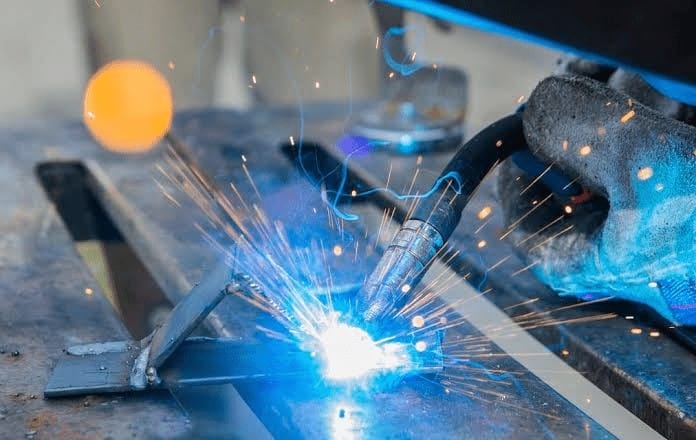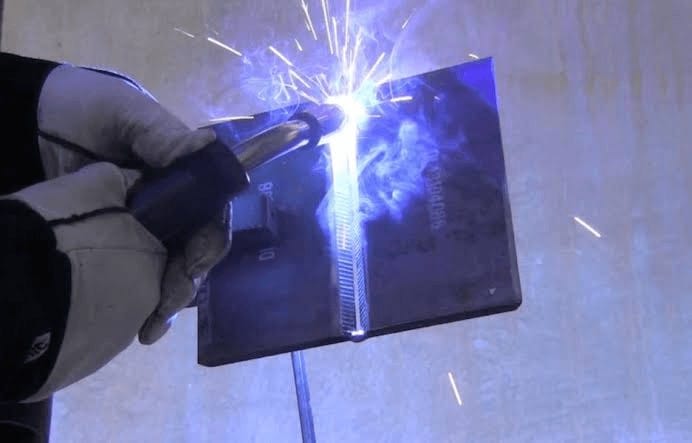Arc welding leverages on the creation of an electric arc that melts the metals hence joining them together. The electric arc is created between the base metal and the consumable/non-consumable electrode. Electricity can either be Alternating currents (AC) or Direct current (DC). The resulting electric arc created is under intense heat of up to 6,500˚F. This is enough to melt most metals hence gluing them together.
The problem with such intense temperatures is it exposes the metal surfaces to contaminants. To protect the arc and reaction with oxygen, the welder will use shielding gas. Once the weld cools the metals will have joined together.
There are various types of arc welding techniques depending on whether they use a consumable electrode or non-consumable electrode.
Problems with welding thin metal sheets
A nice MIG welder can be quite expensive making the idea of welding thin sheets a challenge. You also have to purchase other accessories like regulators, shielding gas cylinders, and wire feeding mechanisms spare parts. The problem with MIG welders is they are quite bulky making them hard to move around. The inert gas is also prone to been blown away outside. The other option is blazing. Arc welding generates a lot of heat which when placed on the thin sheets subjects them to many distortions. It is for this reason that welders will go for MIG or TIG welding.
Gas metal arc welding (GNAW)
This is also commonly referred to as Metal inert gas welding (MIG). In this instance, you feed a continuous a heated solid wire electrode to weld pool. This heats the metallic surfaces and joins them together. In addition, there is a continuous feeding of the weld with inert gases to protect it from contaminants.
GMAW is one of the most effective ways to join thin sheets of metal like austenitic stainless steel or carbon steel. The gauge materials often have a thickness of 18-ga to 0.1875-in for the stainless steel or -24-ga to 0.1875-in for the carbon steel. Applications for thin metal are expansive with usage being seen in automotive industry and in the HVAC.
Shielded Metal arc welding (SMAW)
This is also known as stick welding and occurs when your arc is struck between the work piece and flux coated electrode. Due to the electric current been formed the work piece surface and rod melt resulting in a weld pool. To protect the weld pool from oxidation and contamination, the flux coating melts to form shielding gas.
Creating the ideal weld mode for thin sheets

If you are going to have a good weld on thin sheets then you have to be extra careful to minimize distortions. The weld mode has to be optimal for perfect welding of thin sheets. Most of the welders will use the short circuit transfer mode due to its low heat production. Alternatively, you can use the pulse mode that allows as you can regulate the travel speed hence control heat input. There was a time welding over thin sheets was a big issue but innovations have led to the introductions of new welding machines that can be easily programmed for pulse-on-short-circuit and pulse-on-pulse. This allows one to program the preset time hence giving one better control of power supply.
The other method of reducing welding distortions in thin metals is to use sequencing welding. If you have a thin gauge material you can reduce the distortions be spreading out more smaller welds over the joint.
Shielding gas
Having the right amounts of shielding gas will influence distortions. It will also affect the bead appearance, current level and spatter. Most Short-circuit transfer (SCT) modes are made up of argon -75% and 25% of carbon dioxide whenever you are operating on steel. For stainless steel you need a mixture of 90% helium and 7.5% argon and 2.5% carbon dioxide. These combinations are not cast on stone and you can vary your mixtures.
Slope and Inductance
Stainless steel has a lower thermal conductivity that carbon steel hence its filler metals do not transfer heat much. This results in you having a high amount of spatter with result that your bead is not as flat as you would have wished. To improve the weld bead appearance the welder with use a power supply with a slope or induction control. During the process the inductance will slow the power supply response time while the slope limits the short circuit current. This results in a more controlled wire burnoff. As you increase the wire speed you also increase the short circuits per second. This can rise from 20 to more than 200.
Wire diameter
To have the best welding for thin metal then you need to be extra careful in the wire diameter that you select. The right short circuit wire diameters for carbon steel are 0.023, 0.030, 0.035, and 0.045 in and 0.030, 0.035, and 0.045 in. for stainless steel. For extra thin metals you can lower wire diameter for thinner metals. You will also need a DC arc welder with capabilities of 20-25 amps. In addition, try out E6018 or E7018 1/16 in. welding rods. This will apply to a thin sheet of 0.021 inches.
Padding
When padding you operate your welder at low amps. Instead of touch start you strike an arc at first instance. This results in your using the match striking technique. Here as soon as the arc starts you strike the sheet then pull it off while maintaining a continuous arc. Make some straight lines as you move into the working area. Remember to clean up weld of slag.
Working on butt joints

For butt joints the idea is to weld two thin sheets of metal side by side. The problem is you can easily teat the joints apart or burn the joint edges. If you want for this to succeed you have to work towards the joint instead of filling the joint directly. Make some stitches from the side of the base metal and then more on the joint. After it has cooled, clean it up then do some more.
Torch angle
If you want to prevent burning your materials then you need to closely consider the torch angle. You can deploy a pushing torch angle in welding horizontal, flat or overhead positions. To succeed in SCT welding, use short contact tip to work distance of 0.25 to 0.5 inches. Note that if you use higher contact tip distances you will have created a unstable arc that results in higher resistance between the contact tip and the work piece.
Metal preparation
For any welding process there has to be some level of preparation. If you are welding the consider the high temperatures produced and keep away any inflammable items from your workshop. You should wear some basic safety clothing like leather boots, flame resistant jacket, safety glasses and welding helmet. For thin metal sheets that have some level of rust then you need to use grinding to eliminate the rust for MIG welding. Stick welding or flux core electrodes are ideal for rusty metals. Before you start welding ensure that the clamp properly connects to the work metal.
The type of wire you will use for welding largely depends on your type of metal. ER70S-3 is an all purpose wire and you can use it for a variety of metals. If you have a metallic surface that is rusty then go for the ER70S-6 wire. This come with a considerable number of deoxidizers. Thinner metal tend to use a wire with a diameter of 0.023 inches while for thicker metals 0.035 to 0.045 inches would be the most suitable.
Once you are done with the wiring ensure you have the right gas composition. Inert gasses protect the weld from oxidation. The most common blend is 75% argon and 25% carbon dioxide. These gases help protect the carbon in the weld from combining with the oxygen to form carbon monoxide; this is represented by bubbles in the weld. Argon mixture is most preferred as it produces better bead appearance, less spatter and is ideal for carbon steel. If you want more penetration then go with a 100% carbon dioxide, though this gives you more spatter and the bead appearance is rougher.
Lastly, it is all about having the right voltage and amperage. The amount of heat you use will depend on your wire diameter, metal thickness, joint configuration, metal type and kind of shielding gas you use. Most of the welding machines will come with an easy to use chart that guides you as to the amperage to use and for which metal. This allows one to fine tune their welding machine to meet their preferences.
Conclusion
Welding can be complicated when you are doing it for thin metals. Arc welding is one of the most common ways to do this. However, there many factors you need to take into consideration for you to have the right weld. The wire diameter has to be just right. The rule is the thicker the metal the more wire diameter you will need. Having the right amperage and voltage also influences the quality of your joints.
